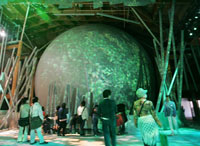
The 2005 World Exposition in central Japan's Aichi Prefecture on Sunday marked the final day of its six-month run. Millions of visitors couldn't bear to part with various new technologies and featuring exhibits like humanoid robots and a frozen mammoth from Siberia.
The total attendance since the March 25 opening topped 22 million visits through Sunday, almost 1.5 times the 15 million target, although a far cry from the 64 million recorded at Japan's first World Expo in Osaka in 1970.
The Seto site closed at 6 p.m. (0900 GMT). The gates at the Nagakute main site closed at 10 p.m. (1300 GMT) and all pavilions at Nagakute were shut by 9 p.m. (1200 GMT) following an Expo 2005 Grand Finale event.
Japanese Crown Prince Naruhito, honorary president of the expo, and Japanese Prime Minister Junichiro Koizumi attended a closing ceremony Sunday afternoon at the expo's Nagakute main site where the expo flag was handed over to the Chinese city of Shanghai, host of the next World Expo in 2010.
The crown prince said he hoped visitors' experiences at the Aichi Expo "will spread throughout the globe and become an immense movement to overcome the many serious issues faced by the world today."
Koizumi said he hoped the event will help promote the concept of "mottainai", which means "do not waste resources" in Japanese and which was used by Nobel Peace Prize laureate Wangari Maathai of Kenya as the theme of a new global campaign she launched after her expo visit in March.
With Sunday falling at the end of a three-day weekend in Japan, an estimated 41,300 visitors were lined up -- including many who had waited overnight -- when the gates opened at around 8:10 a.m.,50 minutes earlier than usual due to the large crowd.
Within minutes, the visitors raced toward popular pavilions and immediately formed long lines where waiting time was as much as eight hours.
"I have been the expo site for more than 20 times. I love all pavilions here," said Takahashi Kazuri, a middle school teacher from Osaka.
"I told students interesting stories about my expo visits and suggest them come to expo site with their parents because the event is attractive for both children and adults," he added
Marilyn Zeweiruta, a volunteer working at the Britain Pavilion, said it is a pity that the expo can't last longer because she made many friends at other countries' pavilions and felt sad to say goodbye to them.
Four international organizations and 121 countries, as well as local governments and companies such as Toyota and Toshiba sponsored pavilions to raise awareness about global environmental issues under the Aichi Expo's theme of "Nature's Wisdom".
Among the state-of-the-art technologies put into practical use were robot guides that can speak four languages, a magnetically levitated train service and other futuristic forms of transportation, and new energy systems that utilize biodegradable garbage to produce electricity used at the expo sites.
The expo also served as a diplomatic opportunity for Japan, with a total of nine royal family members, 18 heads of state and 16 prime ministers from participating countries making official visits during the period. Among them, 34 met with the Japanese premier.
During the six months, guests and dignitaries from 117 countries and the United Nations have visited Japan for the Aichi Expo and a total of 110 National Day events were held at the expo site. Chinese Vice Premier Wu Yi, and Seif al-Islam Gadhafi, the second son of Libyan leader Moammar Gadhafi, were among the guests.
The Aichi Expo was the first world expo in the 21st century and Japan's first in 35 years since the Osaka Expo.
(Xinhua News Agency September 26, 2005)
|

